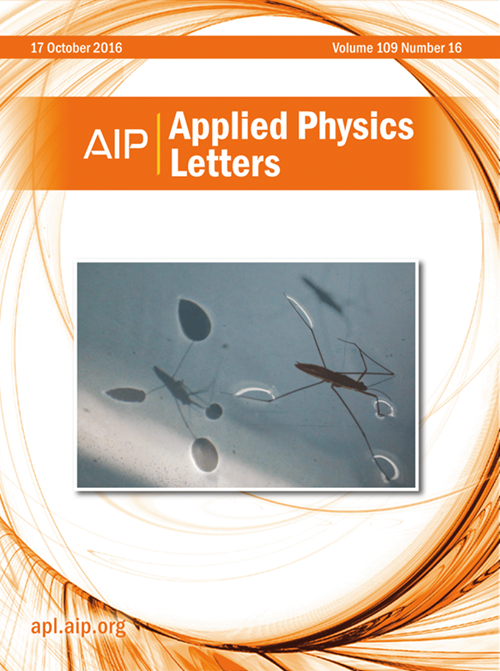在蓝宝石、Si、GaN和SiC上mocvd生长的氮化钪薄膜的结构和电学性能
IF 3.5
2区 物理与天体物理
Q2 PHYSICS, APPLIED
引用次数: 0
摘要
研究二元ScN的生长和性能有助于理解其与GaN和AlN组成的铁电三元合金,但目前还没有金属有机化学气相沉积(MOCVD)生长ScN的数据。在这项工作中,MOCVD证明了ScN生长使用Sc前体(EtCp)2Sc(dbt)。为了研究生长参数对mocvd生长的ScN性能的影响,我们测试了广泛的生长温度、压力和V/III比。在c-蓝宝石、(0001)GaN、Si面4H-SiC和(001)Si上沉积了大约100 nm厚的ScN薄膜,生长速率为0.06至0.20 Å/s。x射线衍射测量表明,ScN薄膜在蓝宝石和氮化镓上都是单(111)取向的。霍尔效应测量显示样品中的n型电荷非常高。蓝宝石上ScN的载流子浓度在2.1 × 1020 ~ 7.2 × 1020 cm−3之间,电子迁移率在20 ~ 7 cm2 V−1 s−1之间。GaN上的ScN薄膜载流子浓度为9.6 × 1019 ~ 2.5 × 1020 cm−3,电子迁移率为42 ~ 8.5 cm2 V−1 s−1。蓝宝石薄膜上的ScN的片电阻最低为45 Ω/□(电阻率为5.2 × 10−4 Ω-cm)。这些结果表明,通过MOCVD生长将ScN集成到下一代氮化物电子器件中具有潜力。本文章由计算机程序翻译,如有差异,请以英文原文为准。
Structural and electrical properties of MOCVD-grown scandium nitride thin films on sapphire, Si, GaN, and SiC
Investigation of the growth and properties of binary ScN can aid in the understanding of its ferroelectric ternary alloys with GaN and AlN, but there are no existing data for ScN grown by metalorganic chemical vapor deposition (MOCVD). In this work, ScN growth by MOCVD was demonstrated using the Sc precursor (EtCp)2Sc(dbt). A broad range of growth temperatures, pressures, and V/III ratios were tested to investigate the impact of growth parameters on the properties of MOCVD-grown ScN. Approximately 100 nm-thick ScN films with growth rates from 0.06 to 0.20 Å/s were deposited on c-sapphire, (0001) GaN, Si-face 4H-SiC, and (001) Si. X-ray diffraction measurements showed that ScN films were solely (111)-oriented on both sapphire and GaN. Hall effect measurements revealed very high n-type electrical charge in the samples. The carrier concentrations of ScN on sapphire ranged from 2.1 × 1020 to 7.2 × 1020 cm−3, with electron mobilities in the range of 20–7 cm2 V−1 s−1. ScN films on GaN exhibited carrier concentrations from 9.6 × 1019 to 2.5 × 1020 cm−3 and electron mobilities from 42 to 8.5 cm2 V−1 s−1. The lowest sheet resistance of 45 Ω/□ (resistivity of 5.2 × 10−4 Ω-cm) was achieved for an ScN on sapphire film. These results indicate the potential for integrating ScN into the next generation of nitride electronics through MOCVD growth.
求助全文
通过发布文献求助,成功后即可免费获取论文全文。
去求助
来源期刊

Applied Physics Letters
物理-物理:应用
CiteScore
6.40
自引率
10.00%
发文量
1821
审稿时长
1.6 months
期刊介绍:
Applied Physics Letters (APL) features concise, up-to-date reports on significant new findings in applied physics. Emphasizing rapid dissemination of key data and new physical insights, APL offers prompt publication of new experimental and theoretical papers reporting applications of physics phenomena to all branches of science, engineering, and modern technology.
In addition to regular articles, the journal also publishes invited Fast Track, Perspectives, and in-depth Editorials which report on cutting-edge areas in applied physics.
APL Perspectives are forward-looking invited letters which highlight recent developments or discoveries. Emphasis is placed on very recent developments, potentially disruptive technologies, open questions and possible solutions. They also include a mini-roadmap detailing where the community should direct efforts in order for the phenomena to be viable for application and the challenges associated with meeting that performance threshold. Perspectives are characterized by personal viewpoints and opinions of recognized experts in the field.
Fast Track articles are invited original research articles that report results that are particularly novel and important or provide a significant advancement in an emerging field. Because of the urgency and scientific importance of the work, the peer review process is accelerated. If, during the review process, it becomes apparent that the paper does not meet the Fast Track criterion, it is returned to a normal track.
 求助内容:
求助内容: 应助结果提醒方式:
应助结果提醒方式:


